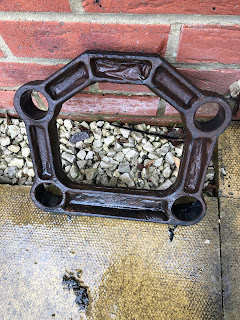Having spent ages cleaning, stripping and prepping bits, it felt like a major step forward to start contemplating actually beginning to build up the new chassis, starting with the front suspension.
 |
| Service parts - not a lot to show for 300 quid! |
The donor vehicle top and bottom wishbone shafts both had some slight scoring on them so I decided to replace with new parts. SNG had the top shafts in stock but the lower shafts are a special item and were on 1-2 weeks back order.
Having read through the AK Build Manual a few times, assembly of the front suspension looked quite straightforward and I was looking forward to some rapid progress......
Yeah right!
The first issue was that my replacement upper wishbone shafts didn't pass through the tubes in the AK chassis. Not a massive problem, just required some fettling with a round file to remove some excess powdercoat and open out the tubes very slightly.
Next step was to fix the upper ball joints to the AK upper wishbones. The ball joints sit in a recess in the wishbone and are fixed in place with M10x75 bolts and secured with M10 Nyloc nuts.
 |
| Parts for upper wishbone |
I found that there was quite a bit of play between the wishbone housing and the balljoints so I added another M10 washer in-between the two to take up the slack. The M10 bolts were then tightened enough just to cinch the balljoint housing onto the balljoint itself and stop any movement. The AK Gen III wishbones have elongated holes to allow camber to be set at a later date so these bolts are not fully torqued up at this stage.
Next was to assemble the offside upper wishbone to the chassis using the new wishbone bolt and 1 1/4" x 5/8" washers as spacers. AK recommend three washers; I put two at the front and one at the rear for initial assembly.
Bearing in mind that all the wishbones and washers might need to be disassembled and reassembled when setting the front caster angles (reading ahead in the AK Manual) I elected not to grease up all the shafts at this stage, so everything was dry assembled.
 |
| First Upper Wishbone done! |
The process was then repeated for the nearside upper wishbone.
Next job was to fit the lower wishbones. As I was still waiting for the new lower wishbone shafts to arrive I temporarily used the original donor shafts for initial assembly. The lower wishbones use 1 1/2" by 7/8" washers as spacers; on the offside 3 washers are fitted to the front of the chassis and one to the rear. Getting all these washers in required some gentle application of a pry bar to create enough of a gap to insert the final washer and some gentle taps with a rubber mallet to ease it into the right position.
 |
| Offside Lower Wishbone installed |
The offside wishbone is exactly the same except that the AK Build manual suggests 3 or 4 washers to be installed at the front of the chassis and none at the rear. Despite judicious use of the pry bar I could not get close to getting 4 washers in at the front and decided 3 was good enough!
Next step was to fix the lower ball joints to the stub axles. The replacement ball joints I purchased included the fixing bolts although I needed to buy some M8 spring washers to fix (as per the AK Build Manual). It is also recommended to apply thread lock to these bolts. Amazon supplied a disappointingly small bottle of Locktite (at a disappointingly astronomical price. Note to self - check that size of bottle being supplied is the same as the one in the product photograph...)
 |
| Parts for lower balljoint / upright assembly |
Assembly was straightforward and fixing bolts were torqued down to 41 lbf ft (as per the Jaguar XJ40 Haynes Manual)
 |
| Balljoint fixed to front upright |
The stub axle assemblies are then fixed to the upper and lower wishbones. I tightened the ball joint retaining nuts down sufficiently to fix the alignment of the ball joints but did not torque down bolts fully at this stage.
The last thing to do before setting the caster angles on the front uprights is to tap out the M6 holes in the uprights where the splash guard would be fitted. These were actually already tapped on my uprights but the threads were not protected during powder coating, so I ran a tap through them in any case just to clean out the threads.
 |
| Tapping out M6 holes in front upright |
An M6 machine screw is then fitted into the upper hole and another machine screw loaded with M6 washers is fitted into the lower hole.
 |
| M6 screw top / M6 screw & washers bottom |
Next job is to level up the chassis and wishbones and check front caster angles!









































